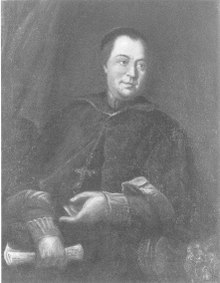Dominicus Otto
Dominicus Otto (real name Johannes Antonius Aloisius Otto ; born June 21, 1716 in Bamberg ; † July 10, 1773 ) was abbot of the Benedictine monastery in Münsterschwarzach from 1766 to 1773 .
Münsterschwarzach before Otto
The large field yields of the early 18th century had made the Münsterschwarzach Abbey rich. The tithe farms in the monastery villages were expanded and henceforth represented the power of the monastery over its surrounding area. At the same time, the renovation of the monastery buildings began, which culminated in the new building of the abbey church. Balthasar Neumann began building the new church under Januarius Schwab in 1727 . The building was completed in 1743 under Christophorus Balbus .
In addition to the new, baroque standard of the monastery community, which was evident to the outside through the magnificent buildings, the abbey's scientific heyday came. Young professed people no longer had to travel to Würzburg to study, but could study directly in the abbey. In the second half of the 18th century, however, the Enlightenment began to question the previously generally valid rights of the church and its monasteries in rural areas.
Life
Early years
Dominicus Otto was born on June 2, 1716 between 11 a.m. and 12 noon as Johannes Antonius Aloisius Otto in Bamberg. His parents were respected citizens in the episcopal city. Johannes Michael was senior secretary and chamber consultant in the city. His mother was Maria Katharina Otto. No sources have come down to us from the childhood and youth of the future abbot; his name did not appear again until 1730/1731 when he enrolled as a student of philosophy at the Bamberg Academy .
After completing his studies, he entered the Benedictine monastery in Münsterschwarzach in 1734. On 21 September 1737 he became subdeacon , on September 20, 1738 Deacon . He received his presbytery on December 17, 1740. Due to the recognition of the inner-monastery studies by the University of Würzburg, Otto was able to study again in Münsterschwarzach. Now he turned to theology. Before his abbatiate , Otto took on several tasks within the monastery . At first he worked as a sacristan and soon rose to become head chef .
This was followed by the office of land master before he was sent to the monastery villages of Dimbach and Stadelschwarzach as a cooperator at the end of 1747 . In the sixties Dominicus Otto took over the pastoral activities in Nordheim am Main and was pastor of the village in the years 1761–1766. Due to the many offices that he held in the monastery community and that also took him to the surrounding area of the abbey, he soon rose to become an advisor to the abbot Christophorus Balbus.
As abbot
After his resignation in 1761 and the early death of his successor, an abbot had to be re-elected in 1766. Several ballots were necessary on November 24th and Otto was finally elected chairman with a majority of 17 out of 30 votes. On January 22, 1767, the new abbot was confirmed by Prince-Bishop Adam Friedrich von Seinsheim . Adam Friedrich benedizierte him on 25 January of the same year for the 68th abbot of Münsterschwarzach.
Little is known about Dominicus Otto's tenure in Münsterschwarzach. Although the monastic life flourished through the turn to science and also the study at the monastery university attracted many professions , the abbey was separated from the other Franconian monasteries. The Würzburg prince-bishops tried to prevent "their" monasteries from being reorganized and refused to agree to join a congregation .
This was also connected with the Enlightenment, which called for a turn to the modern state and a distance from the absolutist ideas of the early modern period. The church representatives of the Prince Diocese of Würzburg were increasingly no longer recognized as authorities. A development began which reached its climax in 1803 with the dissolution of the Franconian monasteries. Dominicus Otto died on July 10, 1773 and was buried in Münsterschwarzach.
coat of arms
The symbols of the abbot Dominicus Otto's coat of arms are heavily based on the monastery coat of arms. Description: A lowered red rafter in silver over a six-pointed gold star. The crest is formed by two buffalo horns with a star between them. The rafter indicates the founder of the monastery, Count Megingaud, while the star symbolizes the reformer Egbert .
A version of the coat of arms is on the old town hall of Stadelschwarzach . There it is surrounded by the coat of arms of the abbey. Furthermore, the coat of arms is shown on the portrait of the abbot.
literature
- Kassius Hallinger: Chronology of the abbots of Münsterschwarzach a. M. (1390-1803) . In: Abtei Münsterschwarzach (Ed.): Abtei Münsterschwarzach. Works from their history . Münsterschwarzach 1938.
- Johannes Mahr: Münsterschwarzach. 1200 years of a Franconian abbey . Münsterschwarzach 2002.
Web links
Individual evidence
- ↑ Mahr, Johannes: Münsterschwarzach. 1200 years of a Franconian abbey . P.56.
- ↑ Hallinger, Kassius: The chronology of the abbots of Münsterschwarzach . P. 121.
- ↑ Mahr, Johannes: Münsterschwarzach. 1200 years of a Franconian abbey . P. 58.
- ^ Bernhard Peter: Stadelschwarzach, Kirchenburg und Rathaus , accessed on April 7, 2014.
| predecessor | Office | successor |
|---|---|---|
| Sebastian Cönen |
Abbot of Münsterschwarzach 1766–1773 |
Ludwig Beck |
| personal data | |
|---|---|
| SURNAME | Otto, Dominicus |
| ALTERNATIVE NAMES | Johann Anton Aloisius Otto (baptismal name) |
| BRIEF DESCRIPTION | German Benedictine abbot |
| DATE OF BIRTH | June 21, 1716 |
| PLACE OF BIRTH | Bamberg |
| DATE OF DEATH | July 10, 1773 |

